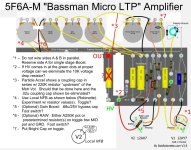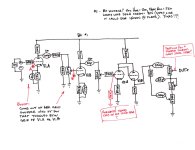Mike McLane
Active member
OK, I can't help myself. I had a Traynor Bassmaster (YBA-1) which is a clone of the '59 Bassman/JTM 45 and it was a glorious (but HEAVY) amp. So I've decided to sketch out a preliminary layout for a pedal version. I reviewed the original schematic, but also found this paired down layout from the Robrobinette site which appears to really fit the bill. Some values vary depending on whether you're looking at the original Fender schematic (the one I found on-line varied slightly from the one found on Robinette's site) or the one shown below which appears to have a "blackface" leaning to the tone stack. Still, some other component values will be required to result in a JTM45 (Robinette outlines those). I plan the unused A side of V1 for a front end single stage Boost. I would appreciate ANY comments or corrections. . . .







